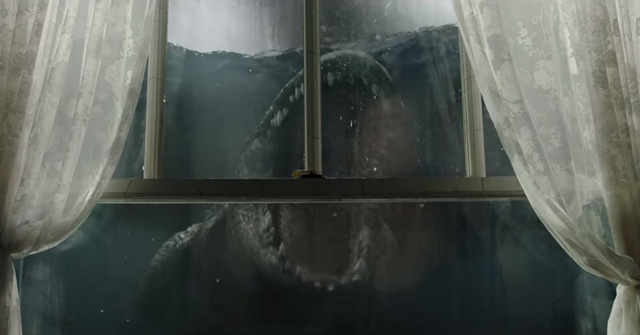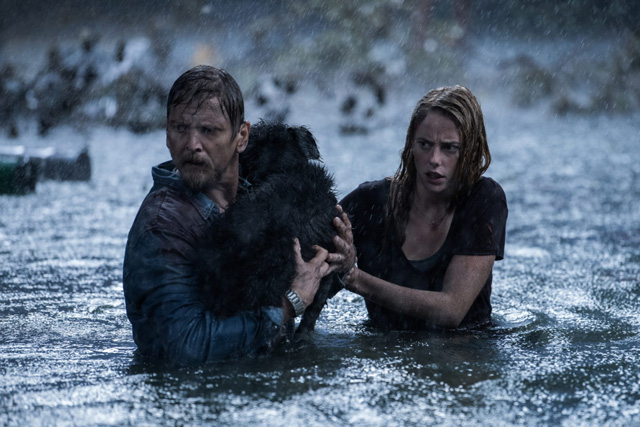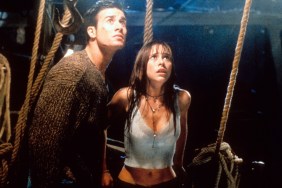Paramount Pictures provided ComingSoon.net the chance to speak with Crawl director Alexandre Aja, the man behind the B-movie hits Piranha 3D and The Hills Have Eyes remake. Starring Kaya Scodelario (The Maze Runner, Extremely Wicked, Shockingly Evil and Vile) and Barry Pepper (Saving Private Ryan, The Green Mile), Crawl is now playing in theaters everywhere!
When a massive hurricane hits her Florida hometown, Haley (Kaya Scodelario) ignores evacuation orders to search for her missing father (Barry Pepper). Finding him gravely injured in the crawl space of their family home, the two become trapped by quickly encroaching floodwaters. As time runs out to escape the strengthening storm, Haley and her father discover that the rising water level is the least of their fears.
Crawl was written by Shawn and Michael Rasmussen, who wrote John Carpenter’s last directorial outing The Ward. Crawl is produced by horror icon Sam Raimi, the man behind the Evil Dead franchise, and Craig Flores, who’s known for his work producing the 300 films.
Crawl marks a deliberate move by the studio to aim for a lower-budgeted horror movie, hoping for more box office success like their recent release, A Quiet Place. Directed by and starring John Krasinski, the film was produced for just $17 million and has since grossed over $314 million at the global box office and is Paramount’s highest grossing domestic release since 2016’s Star Trek Beyond.
RELATED: Crawl Trailer: Hurricanes, Alligators, and Floods, Oh My!

ComingSoon.net: You basically spend the entire movie lying around in water and fifth from the first scene to the last. So how was that whole experience?
Aja: Amazing, when can I come back? No, it was really tough. I mean, it was so difficult. It was so hard, spending 12 hours in the water all day long for 40 days, wetsuit, 50 people in the water around you and rain and rain. The rain and the wind were maybe the most difficult part, more than just the water and but that was a difficult one for sure.
CS: What did you learn about shooting in water when you did “Piranha”?
Aja: I got firsthand experience on my checklist that everything that was told about the making of “Jaws” was true and what a nightmare it was to shoot with water, on the water. I guess I forgot in between. As soon as I went back in the water, I was like, “oh, what was I thinking about?” And I’m sure I will forget again.
CS: What are some of those complications?
Aja: You know, when you deal with water, you’re dealing with physical forces that are basically just that shot off the boat coming inside the living room. it’s a 20-ton pressure that goes against the set. So you cannot do it anywhere. You have to do it in a place where the set won’t be destroyed, go in the river, because the water coming back is another 20-ton pressure coming back to you. That’s just one example. We had to build seven tanks to build each of the sets. The biggest one -I’m sorry, I’m European- so the biggest one was 60 meters and 80 meters. It was pretty gigantic. I mean, it was maybe like six or seven times this room.
CS: Wow.
Aja: It was, you know, like the gas station and all the houses with the water raising up up to two meters. And all this has to resist millions of gallons of water.
CS: What drew you to the script by the Rasmussens, and what changed about the script once you took on the project?
Aja: So I was looking for a project that will give me the opportunity of going back to something more scary, and more suspenseful. My last few movies were more—“Piranha” was more comedy, “Horns” was more like a psychological fable, “Louis Drax” was more like a drama. So I really wanted to go back to “High Tension” and “The Hills Have Eyes” and do something that was more straightforward. I received the script of “Crawl” and along with the script I received that logline, and I fell in love with the logline, that simple idea of this young woman who has to go save her dad during a hurricane category 5 in Florida in a flooded place infested with alligators. That was all I needed. That was for me. And then, I read the script. And the script was, you know, different. The script was all contained in the crawlspace. They were not going out of the crawlspace. It was just the crawlspace, and at the end, the reveal that it was a single alligator in the crawlspace. So I thought it was too small. I wanted to develop the story, the family story, the tie between her and her dad. But I also wanted to open the movie to the hurricane being the main location. And I have that ticking clock of water raising from the basement to the rooftop and the alligators coming more and more. So that’s pretty much what I did to the script.

CS: What were some of the horror tropes that you were trying to stay away from when you were going into “Crawl”?
Aja: I didn’t want to do a monster movie. I didn’t want to do a giant radioactive alligator. I didn’t want to do alligator flying in a tornado. I didn’t want to have the alligators having an agenda of revenge or any type of human projection thing. I wanted to try to make the movie as close as I can from the realm of possibilities, and somehow almost as if based on a true story. And that was kind of the direction.
CS: What kind of input did Sam Raimi have?
Aja: Sam was a blessing for the movie. Sam is the producer that every director will dream to have. He’s someone who really listens to your vision, and then helps you defend your vision with the studio, with all the other partners. It’s a blessing to have someone like him to just be there. He’s not that kind of producer that tried to hone the movie, tried to impose his view. He’s very, very respectful.
CS: The Rasmussens said that after they had sent out the script, all of a sudden they started seeing real news reports of alligators in Florida in hurricanes, so were you also aware that life was imitating your art?
Aja: Yeah, no, no. It’s the marketing department. (laughs)
CS: It’s just like the clowns in the woods for “It”.
Aja: Yeah. Yeah, but you know what? It’s kind of true. I mean, we had a lot of true story that we were based from before. But then, as we were making the movie, as we were writing and doing it, a few things happened, like Queensland got flooded. And 25,000 homes were underwater and the police were saying, “Be careful, don’t get out because there is crocodile everywhere.” So nothing as dramatic as in the movie happened, but the situation was there. The same thing happened in Rio. So you know, it’s happening. Like yesterday, the “New York Post” was telling the story about another alligator in Florida that was found eating another human body in less than a week.
CS: Did you ever get the chance to visit Florida while you were in the pre-production process?
Aja: Oh yeah. Yeah, yeah, I did in fact. Even if I’m French, I did spend a lot of time in Florida before. When I was a kid, I was a kid actor as well, and a very bad one. But anyway, I did one movie in ’91 and I had to spend six months in Miami. So my big thing was to go to the Everglades as many times as I could to see the alligators.
CS: Which film was that?
Aja: Oh it’s a French movie. [“Le Grand Pardon II”]
CS: So when you do a film like this, are you still thinking about “Jaws” and the fact that that’s the seminal film? And are you thinking of how to make it different or possibly homaging it?
Aja: You can’t not think about it because it’s the cornerstone of all creature movies. And you know, it’s one of the movies I watched the most. I was so happy to do a big homage to “Jaws” in “Piranha” with, of course, Richard Dreyfuss playing his old part in the beginning of the movie. I don’t think if I received the script that it was the same, a similar story with a shark, I don’t think I would so that.
C: Too close.
Aja: Yeah.
C: Did you ever entertain the idea of using real alligators in any scenes?
Aja: Yes, yes. We actually found a place in a shelter in Miami where they have a pool where they actually have a pretty big alligator that you can swim with. We were going to try to, you know, do some inserts and shots. But at the end of the day, we didn’t need it because the alligator that the effects people built was so good and so perfect that it was not necessary.
C: So where do you find palm trees in Serbia?
Aja: Oh it’s a tough one. It’s very hard. In fact, you know what? They have a lot of palm trees on the Mediterranean Coast. The problem is that when we were shooting there that all the trees had some kind of mushroom infection, so we couldn’t really move them or use them. So most of them anyway, like the small palm trees came from anywhere in Europe. But all of the other ones, because of the wind had to be CG no matter what, to just create this kind of movement, which is so specific to hurricane wind.
CS: Now we were hearing there were sort of more dialogue scenes that were not included in the film. Was there anything you were particularly sad to see go?
Aja: You know, it was a challenge, because I was split between the 15-year-old movie gore guy that I used to be, wanted to see just alligators and really scary stuff. And the viewer that I became wanted to see the relationship more developed. So we had those, and the challenge was to find the right balance between the two of them. And there is some elements from this. You know, we basically cut one scene, like a big one. And there is some element that I’m missing from that moment that kind of gives you a little bit more background about why Dave, Haley’s father, is there in fact. And I think people will understand it without the scene, but it was more explained, the reasoning. It was just a choice to make at some point, to have that very fast pace, intense survival of having a little bit more back and forth with the dialogue.
Crawl
-
CRAWL











